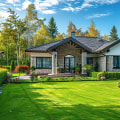Hardscaping refers to the non-living elements of a landscape design, encompassing a wide range of structures and features that provide both functional and aesthetic benefits to outdoor spaces. Unlike softscaping, which involves living elements such as plants, flowers, and trees, hardscaping focuses on the construction and installation of materials like stone, concrete, wood, metal, and brick. These elements are integral to creating a balanced and cohesive landscape, offering durability and structure while enhancing the overall appeal of the area.
One of the primary components of hardscaping is the creation of pathways and walkways. These features are not only practical, providing clear routes for movement, but they also contribute significantly to the aesthetic of a garden or yard. Pathways can be constructed from various materials, including natural stone, pavers, gravel, and bricks, each offering a distinct look and feel. The choice of material and design can greatly influence the ambiance of the outdoor space, from rustic and natural to sleek and modern. Properly designed pathways guide visitors through the landscape, highlighting key areas and ensuring ease of access.
Patios and terraces are also essential hardscaping elements, providing functional outdoor living spaces where people can gather, relax, and entertain. These areas often become the focal points of a garden, equipped with outdoor furniture, barbecues, and other amenities. The materials used for patios and terraces must be durable and weather-resistant, ensuring they can withstand the elements while maintaining their appearance and functionality. Options such as stamped concrete, flagstone, and composite decking are popular for their resilience and aesthetic versatility.
Retaining walls are another critical aspect of hardscaping, particularly in gardens with varying elevations. These structures serve to manage soil erosion, create level planting areas, and add visual interest through tiered designs. Retaining walls can be constructed from materials like stone, brick, or concrete blocks, each providing a different look and level of durability. In addition to their practical benefits, retaining walls can also be designed to include seating areas, planters, and integrated lighting, further enhancing their functionality and appeal.
Water features, such as fountains, ponds, and waterfalls, are captivating hardscaping elements that bring movement and sound to a landscape. These features can range from simple birdbaths to elaborate multi-tiered waterfalls, each adding a unique dynamic to the garden. Water features not only create a tranquil atmosphere but also attract wildlife, contributing to the biodiversity of the area. The design and placement of water features should be carefully considered to ensure they complement the overall landscape and integrate seamlessly with both hardscaping and softscaping elements.
Fire pits and outdoor fireplaces are increasingly popular hardscaping additions, providing warmth and a focal point for social gatherings. These features extend the usability of outdoor spaces into cooler seasons, making them versatile and inviting. Fire pits can be constructed from materials like stone, metal, or brick, with designs ranging from rustic to contemporary. The choice of fuel, whether wood, propane, or natural gas, also influences the design and functionality of the fire feature.
Fences and gates are fundamental hardscaping components that provide privacy, security, and definition to a property. These structures can be made from wood, metal, vinyl, or composite materials, each offering different levels of durability and maintenance requirements. Decorative elements such as lattice panels, trellises, and ornamental gates can enhance the visual appeal of fences, turning them into integral parts of the landscape design.
Decks and pergolas are essential for creating shaded, comfortable outdoor living areas. Decks, typically made from wood or composite materials, offer elevated platforms for lounging and dining, often connected to the main house for easy access. Pergolas, on the other hand, provide partial shade and support for climbing plants, creating a blend of hardscaping and softscaping that enhances the beauty and usability of the garden.
For commercial spaces, hardscaping can significantly impact the functionality and attractiveness of outdoor areas. For instance, in commercial settings like cafes and restaurants, incorporating durable and stylish outdoor furniture from Harrows furniture (www.harrows.co.nz) can elevate the ambiance and functionality of the space. Harrows furniture offers a range of high-quality, aesthetically pleasing options that can withstand heavy use and harsh weather conditions, ensuring that the outdoor area remains inviting and practical for patrons.
In conclusion, hardscaping is a crucial aspect of landscape design that involves the integration of non-living elements to create functional, durable, and visually appealing outdoor spaces. From pathways and patios to retaining walls and water features, hardscaping provides the structural backbone of a landscape, enhancing its usability and beauty. By carefully selecting materials and incorporating various design elements, homeowners and designers can create cohesive and captivating outdoor environments that meet both practical needs and aesthetic preferences.








